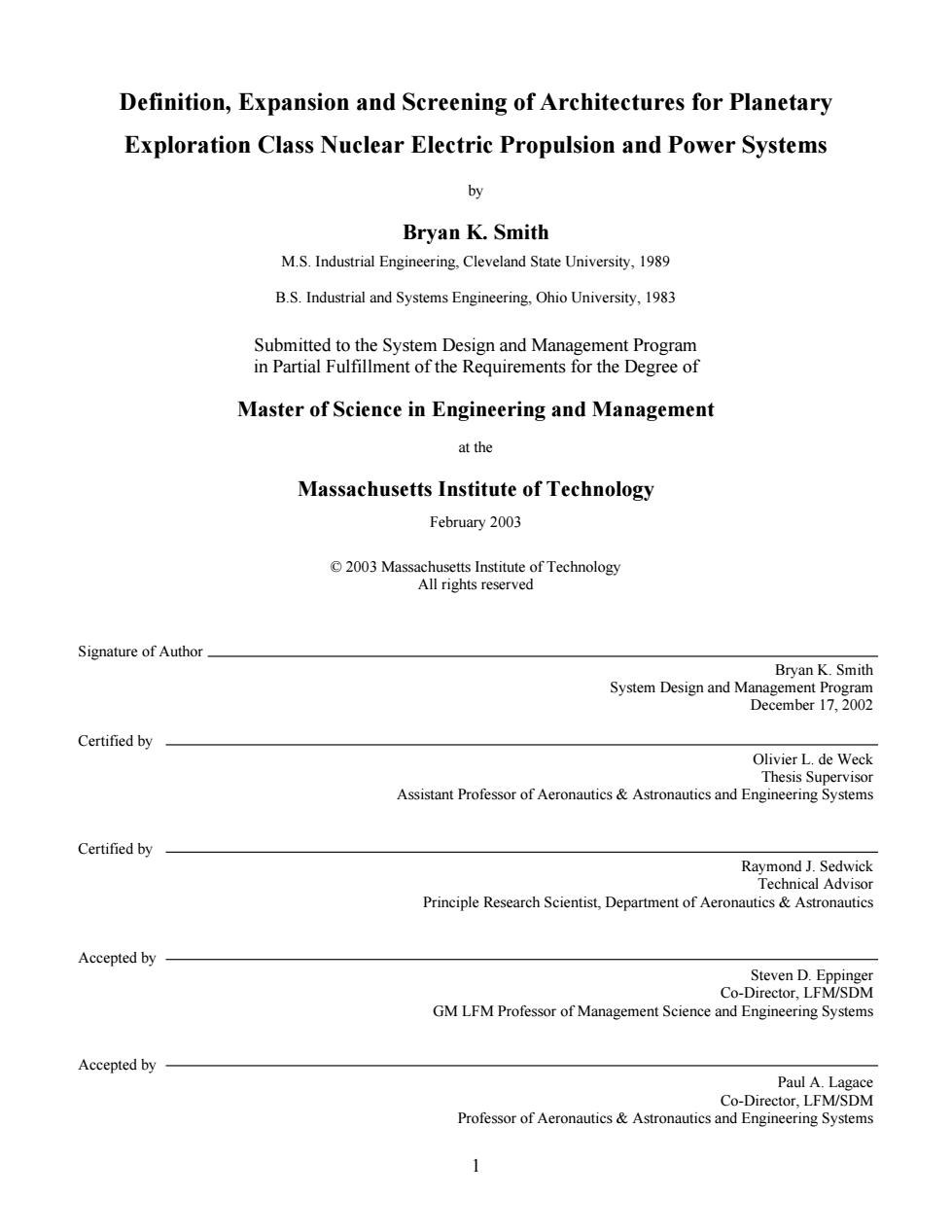
Definition,Expansion and Screening of Architectures for Planetary Exploration Class Nuclear Electric Propulsion and Power Systems by Bryan K.Smith M.S.Industrial Engineering,Cleveland State University,1989 B.S.Industrial and Systems Engineering,Ohio University,1983 Submitted to the System Design and Management Program in Partial Fulfillment of the Requirements for the Degree of Master of Science in Engineering and Management at the Massachusetts Institute of Technology February 2003 2003 Massachusetts Institute of Technology All rights reserved Signature of Author Bryan K.Smith System Design and Management Program December 17,2002 Certified by Olivier L.de Weck Thesis Supervisor Assistant Professor of Aeronautics Astronautics and Engineering Systems Certified by Raymond J.Sedwick Technical Advisor Principle Research Scientist,Department of Aeronautics Astronautics Accepted by Steven D.Eppinger Co-Director.LFM/SDM GM LFM Professor of Management Science and Engineering Systems Accepted by Paul A.Lagace Co-Director.LFM/SDM Professor of Aeronautics Astronautics and Engineering Systems
Definition, Expansion and Screening of Architectures for Planetary Exploration Class Nuclear Electric Propulsion and Power Systems by Bryan K. Smith M.S. Industrial Engineering, Cleveland State University, 1989 B.S. Industrial and Systems Engineering, Ohio University, 1983 Submitted to the System Design and Management Program in Partial Fulfillment of the Requirements for the Degree of Master of Science in Engineering and Management at the Massachusetts Institute of Technology February 2003 © 2003 Massachusetts Institute of Technology All rights reserved Signature of Author Bryan K. Smith System Design and Management Program December 17, 2002 Certified by Olivier L. de Weck Thesis Supervisor Assistant Professor of Aeronautics & Astronautics and Engineering Systems Certified by Raymond J. Sedwick Technical Advisor Principle Research Scientist, Department of Aeronautics & Astronautics Accepted by Steven D. Eppinger Co-Director, LFM/SDM GM LFM Professor of Management Science and Engineering Systems Accepted by Paul A. Lagace Co-Director, LFM/SDM Professor of Aeronautics & Astronautics and Engineering Systems 1
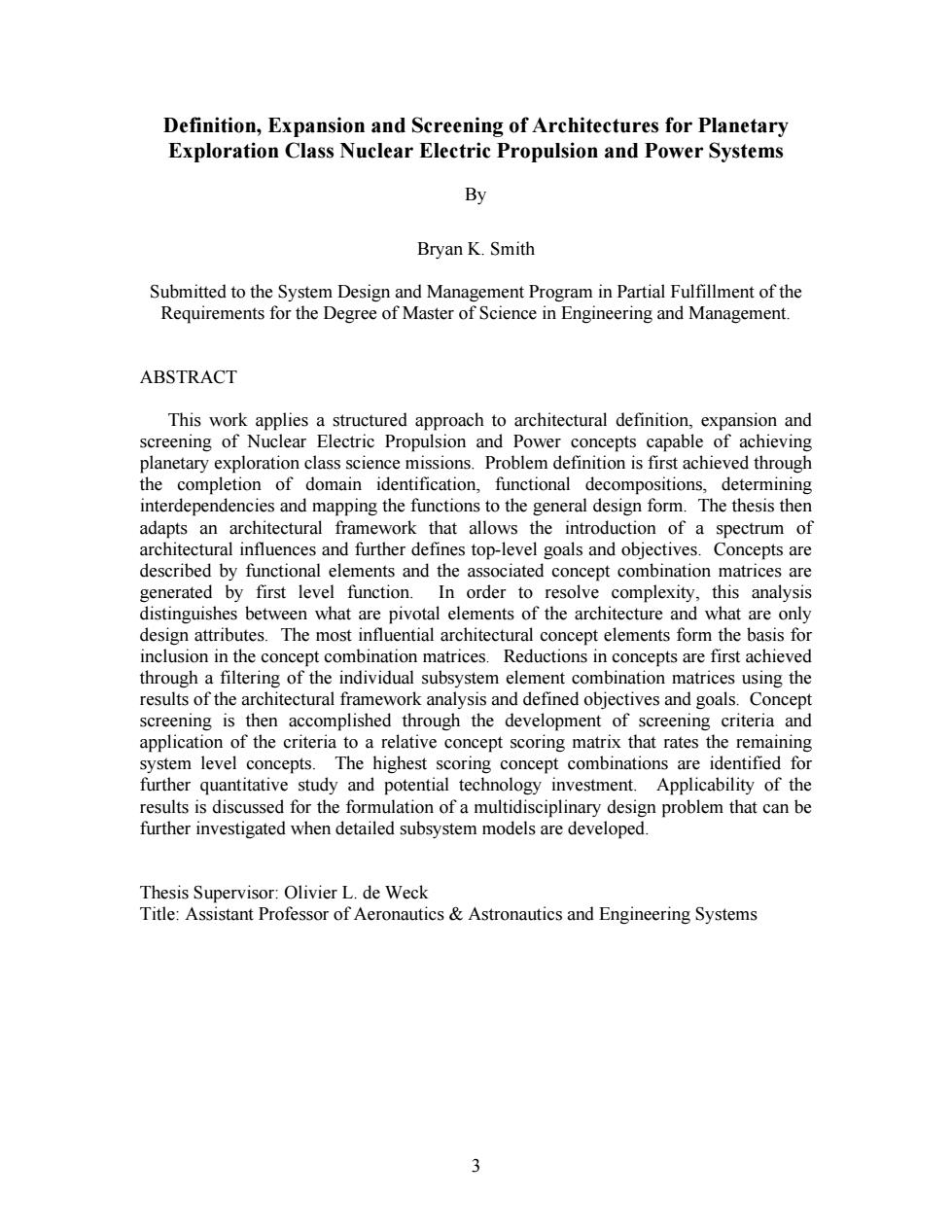
Definition,Expansion and Screening of Architectures for Planetary Exploration Class Nuclear Electric Propulsion and Power Systems By Bryan K.Smith Submitted to the System Design and Management Program in Partial Fulfillment of the Requirements for the Degree of Master of Science in Engineering and Management. ABSTRACT This work applies a structured approach to architectural definition,expansion and screening of Nuclear Electric Propulsion and Power concepts capable of achieving planetary exploration class science missions.Problem definition is first achieved through the completion of domain identification,functional decompositions,determining interdependencies and mapping the functions to the general design form.The thesis then adapts an architectural framework that allows the introduction of a spectrum of architectural influences and further defines top-level goals and objectives.Concepts are described by functional elements and the associated concept combination matrices are generated by first level function.In order to resolve complexity,this analysis distinguishes between what are pivotal elements of the architecture and what are only design attributes.The most influential architectural concept elements form the basis for inclusion in the concept combination matrices.Reductions in concepts are first achieved through a filtering of the individual subsystem element combination matrices using the results of the architectural framework analysis and defined objectives and goals.Concept screening is then accomplished through the development of screening criteria and application of the criteria to a relative concept scoring matrix that rates the remaining system level concepts.The highest scoring concept combinations are identified for further quantitative study and potential technology investment.Applicability of the results is discussed for the formulation of a multidisciplinary design problem that can be further investigated when detailed subsystem models are developed. Thesis Supervisor:Olivier L.de Weck Title:Assistant Professor of Aeronautics Astronautics and Engineering Systems 3
Definition, Expansion and Screening of Architectures for Planetary Exploration Class Nuclear Electric Propulsion and Power Systems By Bryan K. Smith Submitted to the System Design and Management Program in Partial Fulfillment of the Requirements for the Degree of Master of Science in Engineering and Management. ABSTRACT This work applies a structured approach to architectural definition, expansion and screening of Nuclear Electric Propulsion and Power concepts capable of achieving planetary exploration class science missions. Problem definition is first achieved through the completion of domain identification, functional decompositions, determining interdependencies and mapping the functions to the general design form. The thesis then adapts an architectural framework that allows the introduction of a spectrum of architectural influences and further defines top-level goals and objectives. Concepts are described by functional elements and the associated concept combination matrices are generated by first level function. In order to resolve complexity, this analysis distinguishes between what are pivotal elements of the architecture and what are only design attributes. The most influential architectural concept elements form the basis for inclusion in the concept combination matrices. Reductions in concepts are first achieved through a filtering of the individual subsystem element combination matrices using the results of the architectural framework analysis and defined objectives and goals. Concept screening is then accomplished through the development of screening criteria and application of the criteria to a relative concept scoring matrix that rates the remaining system level concepts. The highest scoring concept combinations are identified for further quantitative study and potential technology investment. Applicability of the results is discussed for the formulation of a multidisciplinary design problem that can be further investigated when detailed subsystem models are developed. Thesis Supervisor: Olivier L. de Weck Title: Assistant Professor of Aeronautics & Astronautics and Engineering Systems 3
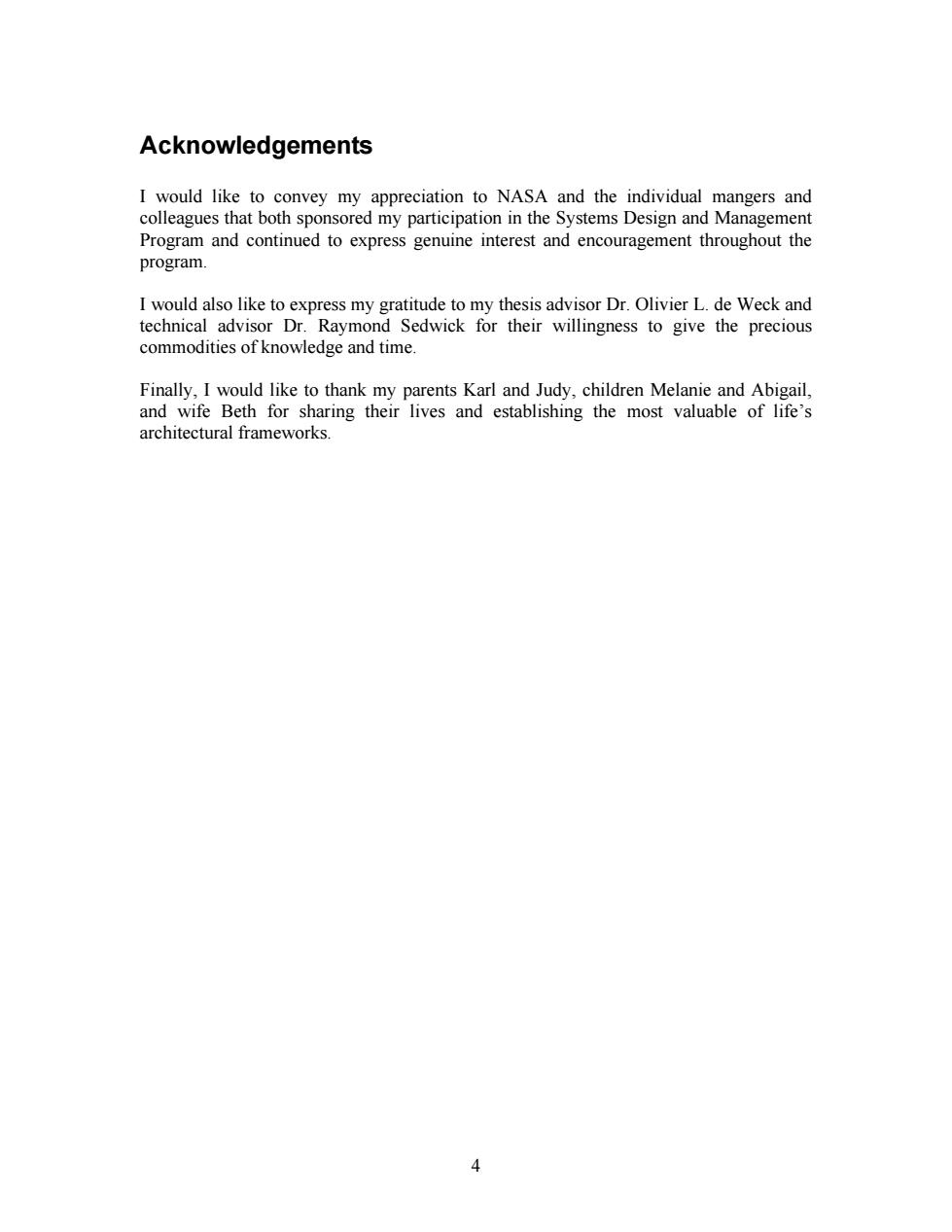
Acknowledgements I would like to convey my appreciation to NASA and the individual mangers and colleagues that both sponsored my participation in the Systems Design and Management Program and continued to express genuine interest and encouragement throughout the program I would also like to express my gratitude to my thesis advisor Dr.Olivier L.de Weck and technical advisor Dr.Raymond Sedwick for their willingness to give the precious commodities of knowledge and time. Finally,I would like to thank my parents Karl and Judy,children Melanie and Abigail, and wife Beth for sharing their lives and establishing the most valuable of life's architectural frameworks. 4
Acknowledgements I would like to convey my appreciation to NASA and the individual mangers and colleagues that both sponsored my participation in the Systems Design and Management Program and continued to express genuine interest and encouragement throughout the program. I would also like to express my gratitude to my thesis advisor Dr. Olivier L. de Weck and technical advisor Dr. Raymond Sedwick for their willingness to give the precious commodities of knowledge and time. Finally, I would like to thank my parents Karl and Judy, children Melanie and Abigail, and wife Beth for sharing their lives and establishing the most valuable of life’s architectural frameworks. 4
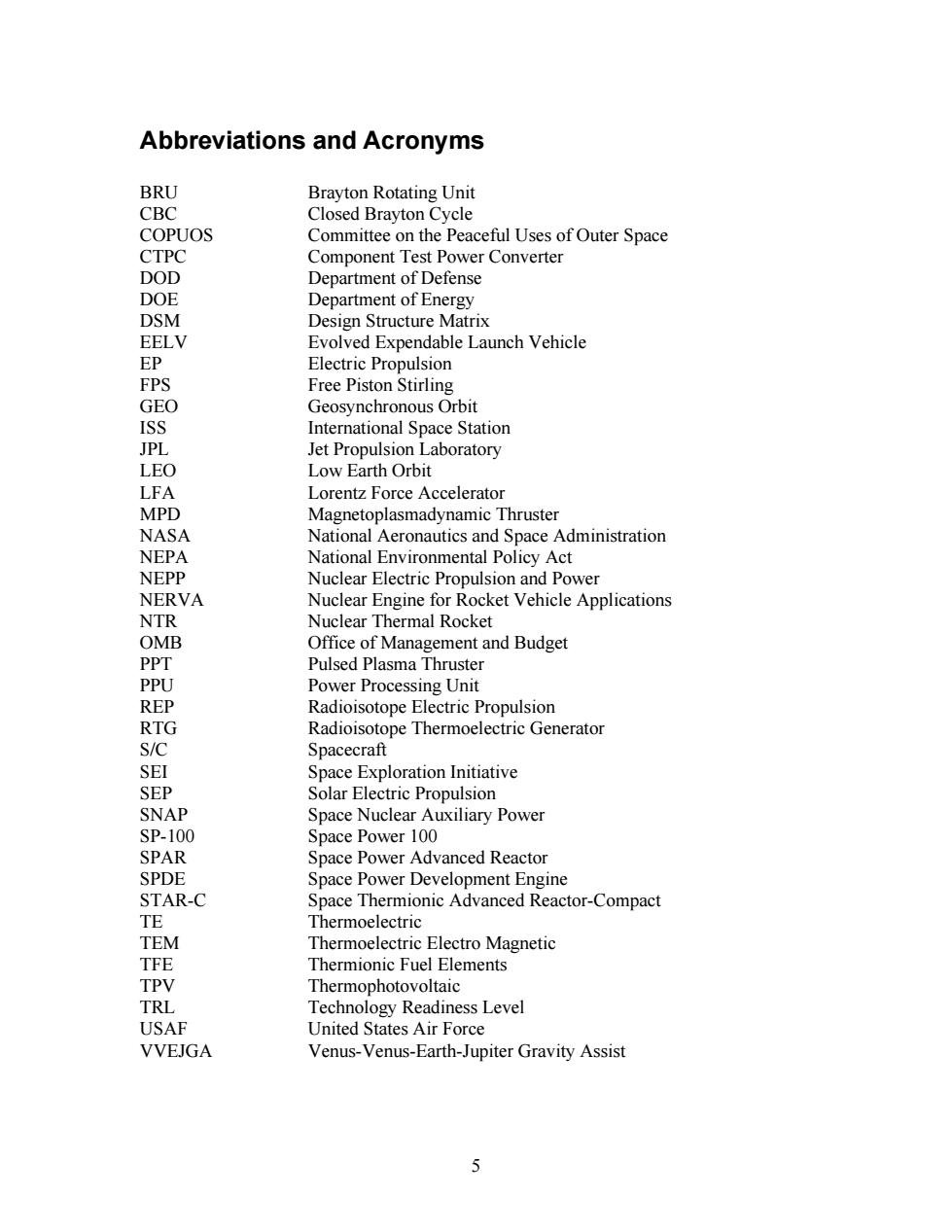
Abbreviations and Acronyms BRU Brayton Rotating Unit CBC Closed Brayton Cycle COPUOS Committee on the Peaceful Uses of Outer Space CTPC Component Test Power Converter DOD Department of Defense DOE Department of Energy DSM Design Structure Matrix EELV Evolved Expendable Launch Vehicle EP Electric Propulsion FPS Free Piston Stirling GEO Geosynchronous Orbit ISS International Space Station JPL Jet Propulsion Laboratory LEO Low Earth Orbit LFA Lorentz Force Accelerator MPD Magnetoplasmadynamic Thruster NASA National Aeronautics and Space Administration NEPA National Environmental Policy Act NEPP Nuclear Electric Propulsion and Power NERVA Nuclear Engine for Rocket Vehicle Applications NTR Nuclear Thermal Rocket OMB Office of Management and Budget PPT Pulsed Plasma Thruster PPU Power Processing Unit REP Radioisotope Electric Propulsion RTG Radioisotope Thermoelectric Generator S/C Spacecraft SEI Space Exploration Initiative SEP Solar Electric Propulsion SNAP Space Nuclear Auxiliary Power SP-100 Space Power 100 SPAR Space Power Advanced Reactor SPDE Space Power Development Engine STAR-C Space Thermionic Advanced Reactor-Compact TE Thermoelectric TEM Thermoelectric Electro Magnetic TFE Thermionic Fuel Elements TPV Thermophotovoltaic TRL Technology Readiness Level USAF United States Air Force VVEJGA Venus-Venus-Earth-Jupiter Gravity Assist 5
Abbreviations and Acronyms BRU Brayton Rotating Unit CBC Closed Brayton Cycle COPUOS Committee on the Peaceful Uses of Outer Space CTPC Component Test Power Converter DOD Department of Defense DOE Department of Energy DSM Design Structure Matrix EELV Evolved Expendable Launch Vehicle EP Electric Propulsion FPS Free Piston Stirling GEO Geosynchronous Orbit ISS International Space Station JPL Jet Propulsion Laboratory LEO Low Earth Orbit LFA Lorentz Force Accelerator MPD Magnetoplasmadynamic Thruster NASA National Aeronautics and Space Administration NEPA National Environmental Policy Act NEPP Nuclear Electric Propulsion and Power NERVA Nuclear Engine for Rocket Vehicle Applications NTR Nuclear Thermal Rocket OMB Office of Management and Budget PPT Pulsed Plasma Thruster PPU Power Processing Unit REP Radioisotope Electric Propulsion RTG Radioisotope Thermoelectric Generator S/C Spacecraft SEI Space Exploration Initiative SEP Solar Electric Propulsion SNAP Space Nuclear Auxiliary Power SP-100 Space Power 100 SPAR Space Power Advanced Reactor SPDE Space Power Development Engine STAR-C Space Thermionic Advanced Reactor-Compact TE Thermoelectric TEM Thermoelectric Electro Magnetic TFE Thermionic Fuel Elements TPV Thermophotovoltaic TRL Technology Readiness Level USAF United States Air Force VVEJGA Venus-Venus-Earth-Jupiter Gravity Assist 5
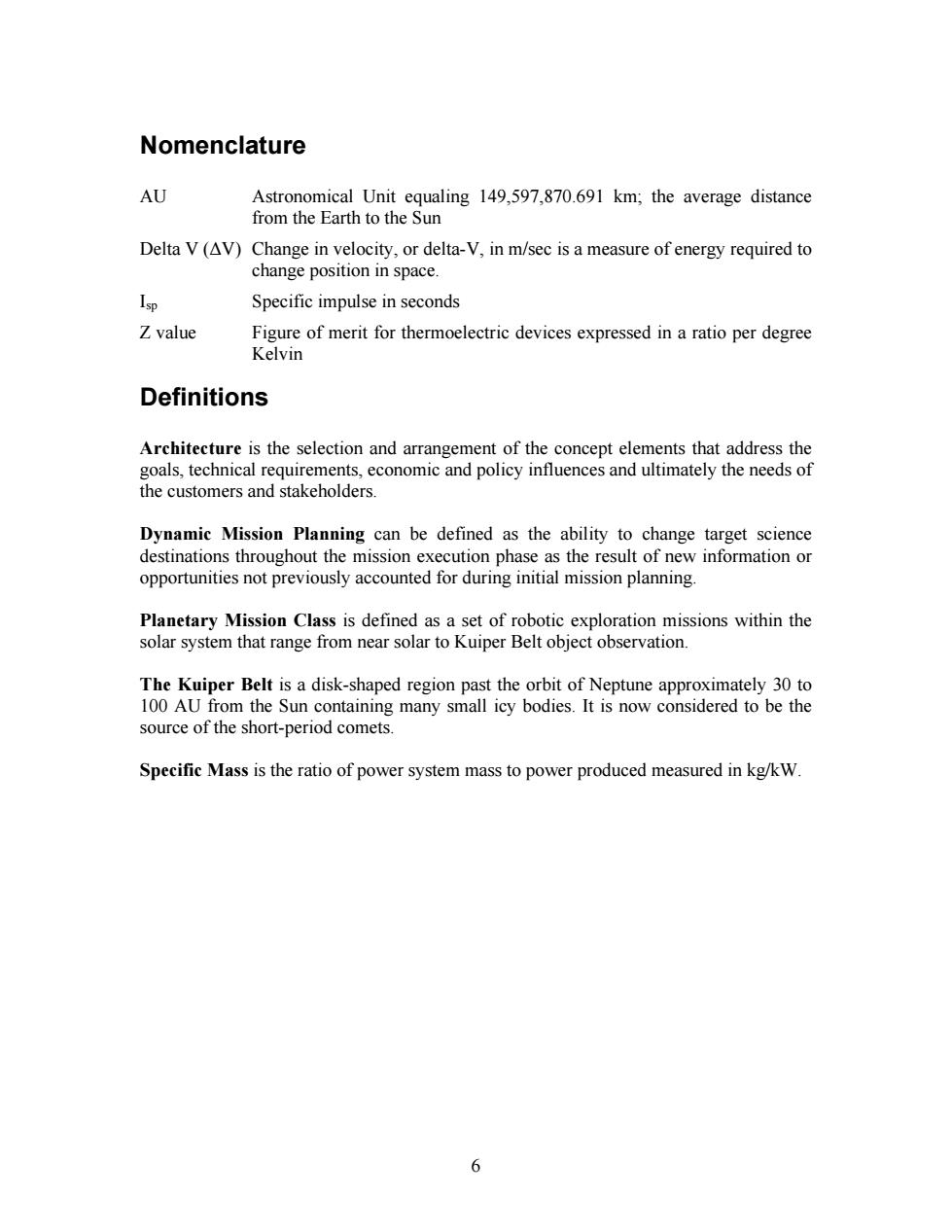
Nomenclature AU Astronomical Unit equaling 149,597,870.691 km;the average distance from the Earth to the Sun Delta V(AV)Change in velocity,or delta-V,in m/sec is a measure of energy required to change position in space. Isp Specific impulse in seconds Z value Figure of merit for thermoelectric devices expressed in a ratio per degree Kelvin Definitions Architecture is the selection and arrangement of the concept elements that address the goals,technical requirements,economic and policy influences and ultimately the needs of the customers and stakeholders. Dynamic Mission Planning can be defined as the ability to change target science destinations throughout the mission execution phase as the result of new information or opportunities not previously accounted for during initial mission planning Planetary Mission Class is defined as a set of robotic exploration missions within the solar system that range from near solar to Kuiper Belt object observation. The Kuiper Belt is a disk-shaped region past the orbit of Neptune approximately 30 to 100 AU from the Sun containing many small icy bodies.It is now considered to be the source of the short-period comets. Specific Mass is the ratio of power system mass to power produced measured in kg/kW. b
Nomenclature AU Astronomical Unit equaling 149,597,870.691 km; the average distance from the Earth to the Sun Delta V (∆V) Change in velocity, or delta-V, in m/sec is a measure of energy required to change position in space. Isp Specific impulse in seconds Z value Figure of merit for thermoelectric devices expressed in a ratio per degree Kelvin Definitions Architecture is the selection and arrangement of the concept elements that address the goals, technical requirements, economic and policy influences and ultimately the needs of the customers and stakeholders. Dynamic Mission Planning can be defined as the ability to change target science destinations throughout the mission execution phase as the result of new information or opportunities not previously accounted for during initial mission planning. Planetary Mission Class is defined as a set of robotic exploration missions within the solar system that range from near solar to Kuiper Belt object observation. The Kuiper Belt is a disk-shaped region past the orbit of Neptune approximately 30 to 100 AU from the Sun containing many small icy bodies. It is now considered to be the source of the short-period comets. Specific Mass is the ratio of power system mass to power produced measured in kg/kW. 6
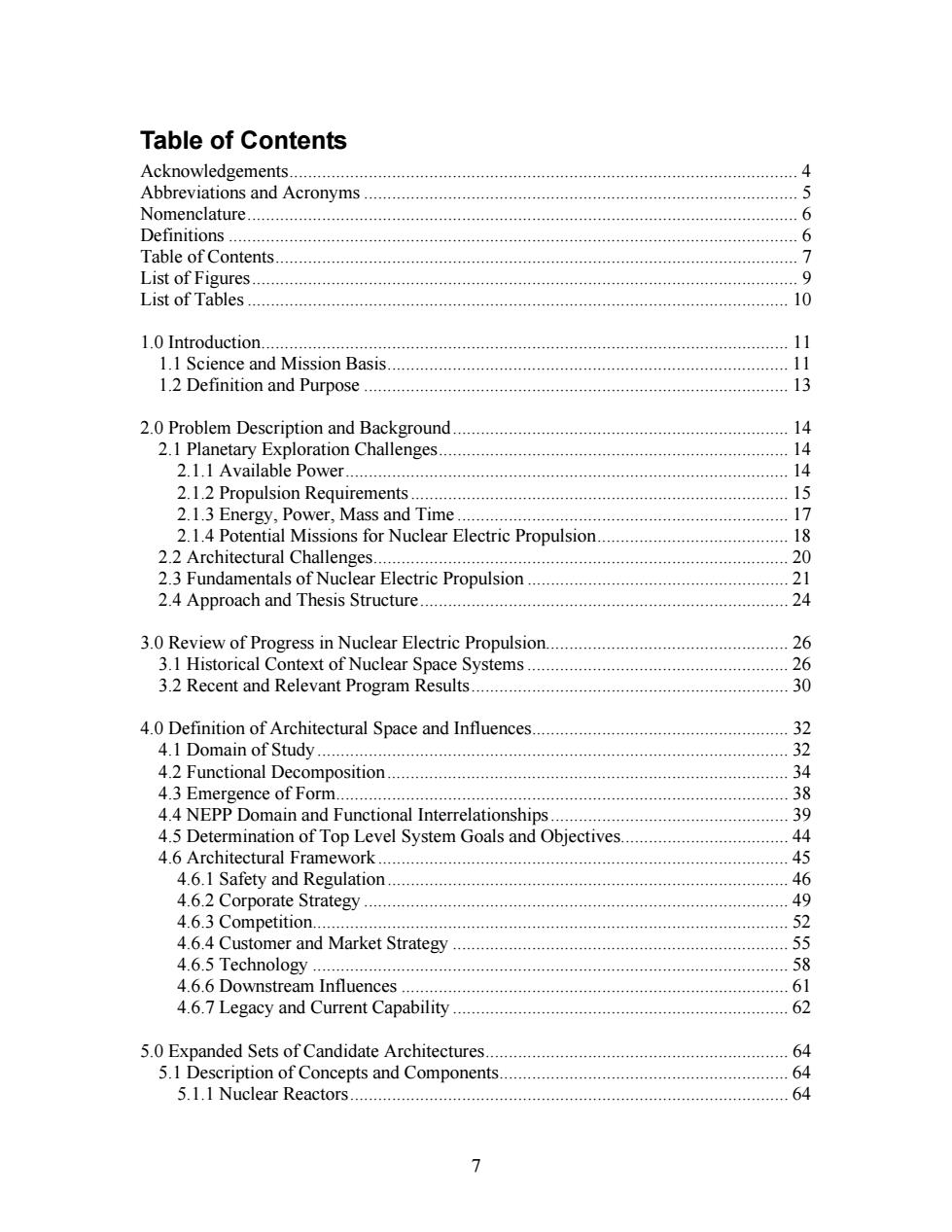
Table of Contents Acknowledgements. 4 Abbreviations and Acronyms 5 Nomenclature..... 6 Definitions..… 6 Table of Contents.… 7 List of Figures. 9 List of Tables. 10 1.0 Introduction..… 11 1.1 Science and Mission Basis............. 11 1.2 Definition and Purpose.................. 13 2.0 Problem Description and Background. 14 2.1 Planetary Exploration Challenges 14 2.1.1 Available Power............. 14 2.1.2 Propulsion Requirements.................. 15 2.1.3 Energy,Power,Mass and Time......... 17 2.1.4 Potential Missions for Nuclear Electric Propulsion. 18 2.2 Architectural Challenges..... 20 2.3 Fundamentals of Nuclear Electric Propulsion 21 2.4 Approach and Thesis Structure.............. 24 3.0 Review of Progress in Nuclear Electric Propulsion 26 3.1 Historical Context of Nuclear Space Systems....... 26 3.2 Recent and Relevant Program Results.... 30 4.0 Definition of Architectural Space and Influences.............................. 32 4.1D0main0 f Study.… 32 4.2 Functional Decomposition.. 34 4.3 Emergence of Form......... 38 4.4 NEPP Domain and Functional Interrelationships. 39 4.5 Determination of Top Level System Goals and Objectives 44 4.6 Architectural Framework................ 45 4.6.1 Safety and Regulation........... 46 4.6.2 Corporate Strategy.............. 49 4.6.3 Competition..... 52 4.6.4 Customer and Market Strategy 55 4.6.5 Technology. 58 4.6.6 Downstream Influences................... 61 4.6.7 Legacy and Current Capability............. 62 5.0 Expanded Sets of Candidate Architectures.. 64 5.1 Description of Concepts and Components. 64 5.1.1 Nuclear Reactors.............. 64
Table of Contents Acknowledgements............................................................................................................. 4 Abbreviations and Acronyms ............................................................................................. 5 Nomenclature...................................................................................................................... 6 Definitions .......................................................................................................................... 6 Table of Contents................................................................................................................ 7 List of Figures..................................................................................................................... 9 List of Tables.................................................................................................................... 10 1.0 Introduction................................................................................................................. 11 1.1 Science and Mission Basis...................................................................................... 11 1.2 Definition and Purpose ........................................................................................... 13 2.0 Problem Description and Background........................................................................ 14 2.1 Planetary Exploration Challenges........................................................................... 14 2.1.1 Available Power............................................................................................... 14 2.1.2 Propulsion Requirements................................................................................. 15 2.1.3 Energy, Power, Mass and Time ....................................................................... 17 2.1.4 Potential Missions for Nuclear Electric Propulsion......................................... 18 2.2 Architectural Challenges......................................................................................... 20 2.3 Fundamentals of Nuclear Electric Propulsion ........................................................ 21 2.4 Approach and Thesis Structure............................................................................... 24 3.0 Review of Progress in Nuclear Electric Propulsion.................................................... 26 3.1 Historical Context of Nuclear Space Systems........................................................ 26 3.2 Recent and Relevant Program Results.................................................................... 30 4.0 Definition of Architectural Space and Influences....................................................... 32 4.1 Domain of Study..................................................................................................... 32 4.2 Functional Decomposition...................................................................................... 34 4.3 Emergence of Form................................................................................................. 38 4.4 NEPP Domain and Functional Interrelationships................................................... 39 4.5 Determination of Top Level System Goals and Objectives.................................... 44 4.6 Architectural Framework........................................................................................ 45 4.6.1 Safety and Regulation...................................................................................... 46 4.6.2 Corporate Strategy ........................................................................................... 49 4.6.3 Competition...................................................................................................... 52 4.6.4 Customer and Market Strategy ........................................................................ 55 4.6.5 Technology ...................................................................................................... 58 4.6.6 Downstream Influences ................................................................................... 61 4.6.7 Legacy and Current Capability ........................................................................ 62 5.0 Expanded Sets of Candidate Architectures................................................................. 64 5.1 Description of Concepts and Components.............................................................. 64 5.1.1 Nuclear Reactors.............................................................................................. 64 7
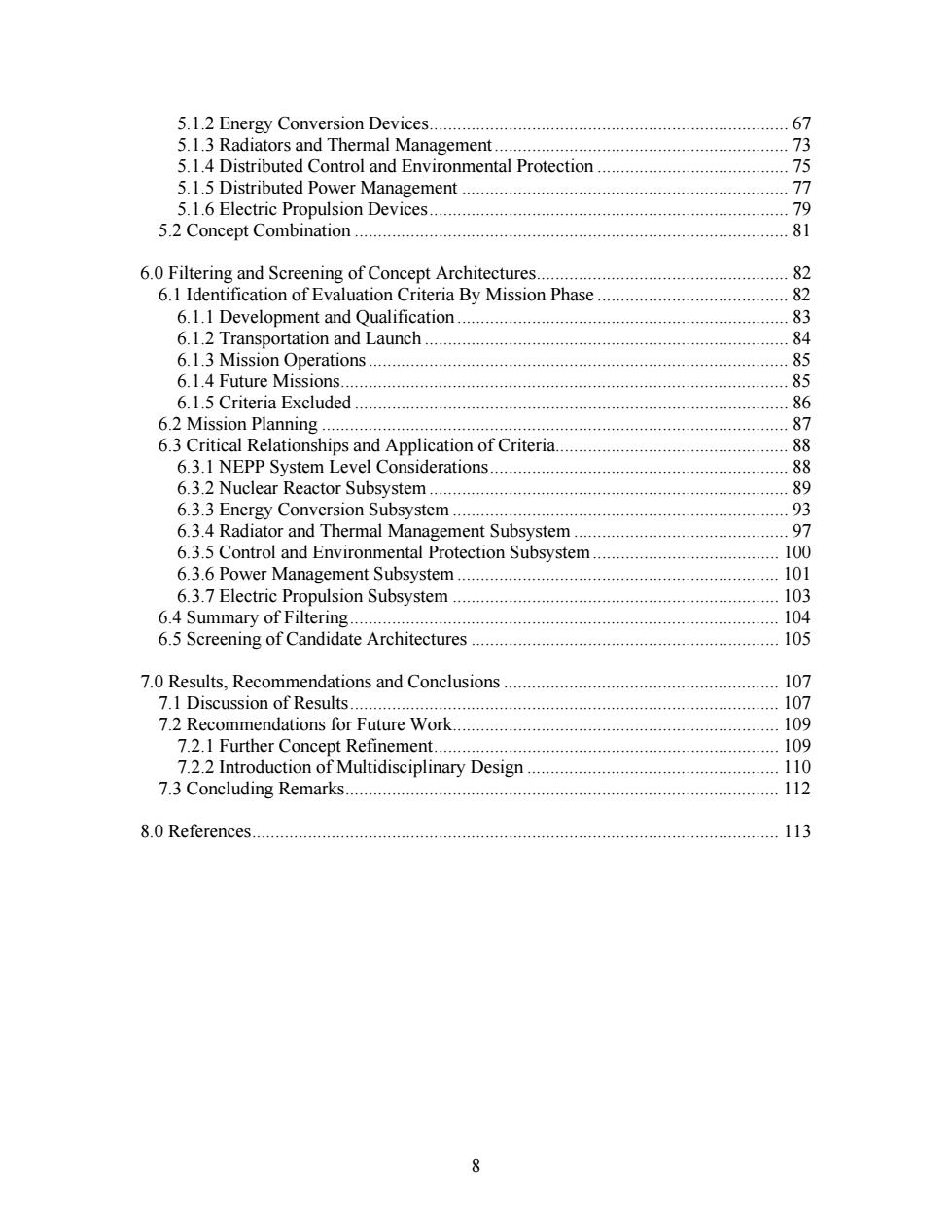
5.1.2 Energy Conversion Devices. 7 5.1.3 Radiators and Thermal Management 73 5.1.4 Distributed Control and Environmental Protection 5 5.1.5 Distributed Power Management 5.1.6 Electric Propulsion Devices............... 79 5.2 Concept Combination.. 81 6.0 Filtering and Screening of Concept Architectures. 82 6.1 Identification of Evaluation Criteria By Mission Phase 82 6.1.1 Development and Qualification................. 83 6.1.2 Transportation and Launch..... 84 6.1.3 Mission Operations..................... 5 6.1.4 Future Missions.. 85 6.1.5 Criteria Excluded. 86 6.2 Mission Planning.......... 87 6.3 Critical Relationships and Application of Criteria.... 88 6.3.1 NEPP System Level Considerations................... 88 6.3.2 Nuclear Reactor Subsystem....................... 89 6.3.3 Energy Conversion Subsystem................ 93 6.3.4 Radiator and Thermal Management Subsystem........ 97 6.3.5 Control and Environmental Protection Subsystem 100 6.3.6 Power Management Subsystem........................ 101 6.3.7 Electric Propulsion Subsystem ................. 103 6.4 Summary of Filtering.............. 104 6.5 Screening of Candidate Architectures............ 。。 105 7.0 Results,Recommendations and Conclusions....... 107 7.1 Discussion of Results.... 107 7.2 Recommendations for Future Work. 109 7.2.1 Further Concept Refinement............ 109 7.2.2 Introduction of Multidisciplinary Design 110 7.3 Concluding Remarks....... 112 8.0 References… 113 8
5.1.2 Energy Conversion Devices............................................................................. 67 5.1.3 Radiators and Thermal Management............................................................... 73 5.1.4 Distributed Control and Environmental Protection ......................................... 75 5.1.5 Distributed Power Management ...................................................................... 77 5.1.6 Electric Propulsion Devices............................................................................. 79 5.2 Concept Combination ............................................................................................. 81 6.0 Filtering and Screening of Concept Architectures...................................................... 82 6.1 Identification of Evaluation Criteria By Mission Phase ......................................... 82 6.1.1 Development and Qualification ....................................................................... 83 6.1.2 Transportation and Launch .............................................................................. 84 6.1.3 Mission Operations.......................................................................................... 85 6.1.4 Future Missions................................................................................................ 85 6.1.5 Criteria Excluded ............................................................................................. 86 6.2 Mission Planning .................................................................................................... 87 6.3 Critical Relationships and Application of Criteria.................................................. 88 6.3.1 NEPP System Level Considerations................................................................ 88 6.3.2 Nuclear Reactor Subsystem............................................................................. 89 6.3.3 Energy Conversion Subsystem ........................................................................ 93 6.3.4 Radiator and Thermal Management Subsystem .............................................. 97 6.3.5 Control and Environmental Protection Subsystem........................................ 100 6.3.6 Power Management Subsystem..................................................................... 101 6.3.7 Electric Propulsion Subsystem ...................................................................... 103 6.4 Summary of Filtering............................................................................................ 104 6.5 Screening of Candidate Architectures .................................................................. 105 7.0 Results, Recommendations and Conclusions ........................................................... 107 7.1 Discussion of Results............................................................................................ 107 7.2 Recommendations for Future Work...................................................................... 109 7.2.1 Further Concept Refinement.......................................................................... 109 7.2.2 Introduction of Multidisciplinary Design ...................................................... 110 7.3 Concluding Remarks............................................................................................. 112 8.0 References................................................................................................................. 113 8
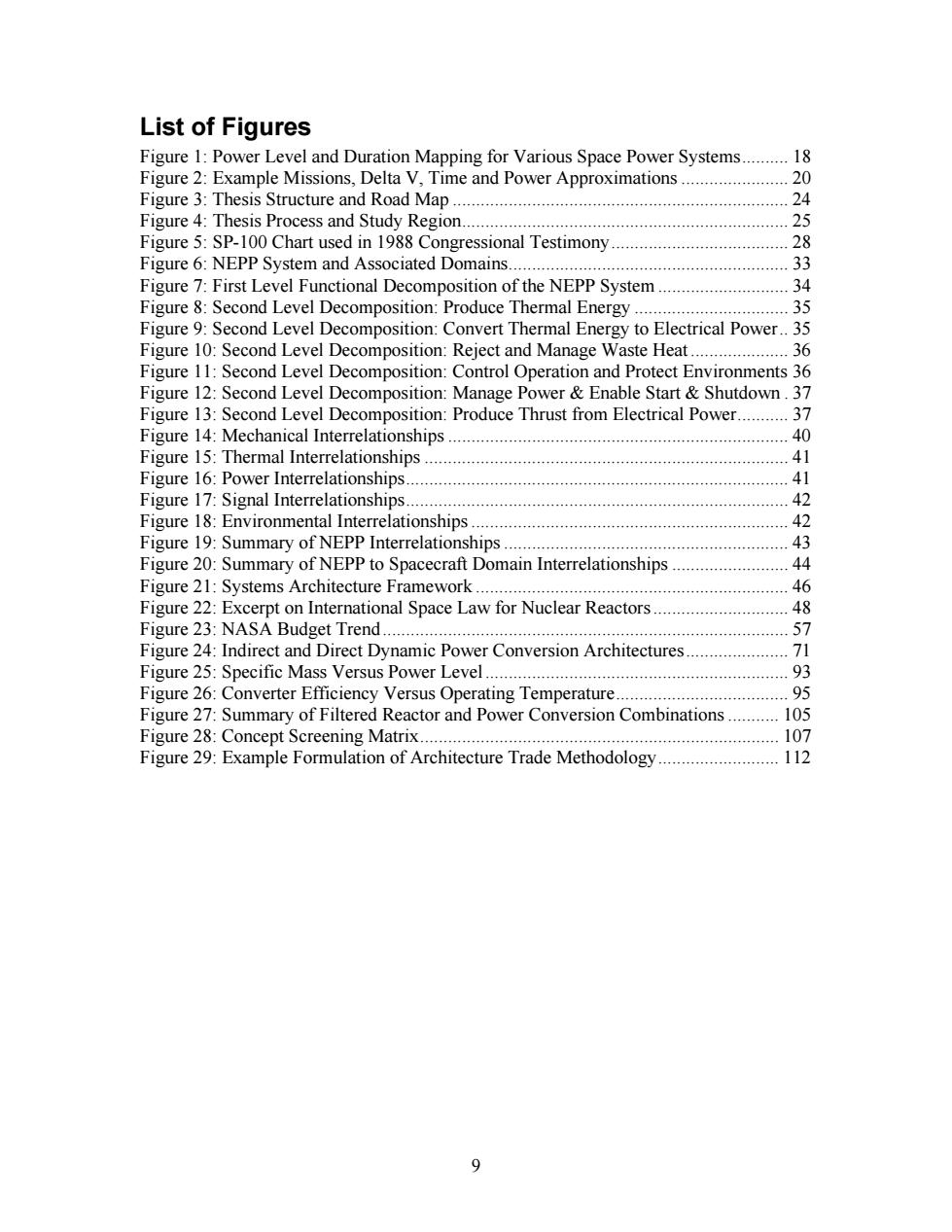
List of Figures Figure 1:Power Level and Duration Mapping for Various Space Power Systems.......... 18 Figure 2:Example Missions,Delta V,Time and Power Approximations 20 Figure 3:Thesis Structure and Road Map.................... 4 Figure 4:Thesis Process and Study Region..... 25 Figure 5:SP-100 Chart used in 1988 Congressional Testimony.................................... 28 Figure 6:NEPP System and Associated Domains.................................... 33 Figure 7:First Level Functional Decomposition of the NEPP System 34 Figure 8:Second Level Decomposition:Produce Thermal Energy............ 35 Figure 9:Second Level Decomposition:Convert Thermal Energy to Electrical Power..35 Figure 10:Second Level Decomposition:Reject and Manage Waste Heat 36 Figure 11:Second Level Decomposition:Control Operation and Protect Environments 36 Figure 12:Second Level Decomposition:Manage Power Enable Start Shutdown.37 Figure 13:Second Level Decomposition:Produce Thrust from Electrical Power. … 37 Figure 14:Mechanical Interrelationships.......... 40 Figure 15:Thermal Interrelationships 41 Figure 16:Power Interrelationships............. 41 Figure 17:Signal Interrelationships................. 42 Figure 18:Environmental Interrelationships.... 42 Figure 19:Summary of NEPP Interrelationships..... 43 Figure 20:Summary of NEPP to Spacecraft Domain Interrelationships 44 Figure 21:Systems Architecture Framework............ 46 Figure 22:Excerpt on International Space Law for Nuclear Reactors............................ 48 Figure 23:NASA Budget Trend............. 57 Figure 24:Indirect and Direct Dynamic Power Conversion Architectures 71 Figure 25:Specific Mass Versus Power Level............ 93 Figure 26:Converter Efficiency Versus Operating Temperature........ 95 Figure 27:Summary of Filtered Reactor and Power Conversion Combinations........... 105 Figure 28:Concept Screening Matrix................. 107 Figure 29:Example Formulation of Architecture Trade Methodology 112 9
List of Figures Figure 1: Power Level and Duration Mapping for Various Space Power Systems.......... 18 Figure 2: Example Missions, Delta V, Time and Power Approximations ....................... 20 Figure 3: Thesis Structure and Road Map ........................................................................ 24 Figure 4: Thesis Process and Study Region...................................................................... 25 Figure 5: SP-100 Chart used in 1988 Congressional Testimony...................................... 28 Figure 6: NEPP System and Associated Domains............................................................ 33 Figure 7: First Level Functional Decomposition of the NEPP System ............................ 34 Figure 8: Second Level Decomposition: Produce Thermal Energy ................................. 35 Figure 9: Second Level Decomposition: Convert Thermal Energy to Electrical Power.. 35 Figure 10: Second Level Decomposition: Reject and Manage Waste Heat ..................... 36 Figure 11: Second Level Decomposition: Control Operation and Protect Environments 36 Figure 12: Second Level Decomposition: Manage Power & Enable Start & Shutdown . 37 Figure 13: Second Level Decomposition: Produce Thrust from Electrical Power........... 37 Figure 14: Mechanical Interrelationships ......................................................................... 40 Figure 15: Thermal Interrelationships .............................................................................. 41 Figure 16: Power Interrelationships.................................................................................. 41 Figure 17: Signal Interrelationships.................................................................................. 42 Figure 18: Environmental Interrelationships.................................................................... 42 Figure 19: Summary of NEPP Interrelationships ............................................................. 43 Figure 20: Summary of NEPP to Spacecraft Domain Interrelationships ......................... 44 Figure 21: Systems Architecture Framework ................................................................... 46 Figure 22: Excerpt on International Space Law for Nuclear Reactors............................. 48 Figure 23: NASA Budget Trend....................................................................................... 57 Figure 24: Indirect and Direct Dynamic Power Conversion Architectures...................... 71 Figure 25: Specific Mass Versus Power Level................................................................. 93 Figure 26: Converter Efficiency Versus Operating Temperature..................................... 95 Figure 27: Summary of Filtered Reactor and Power Conversion Combinations ........... 105 Figure 28: Concept Screening Matrix............................................................................. 107 Figure 29: Example Formulation of Architecture Trade Methodology.......................... 112 9
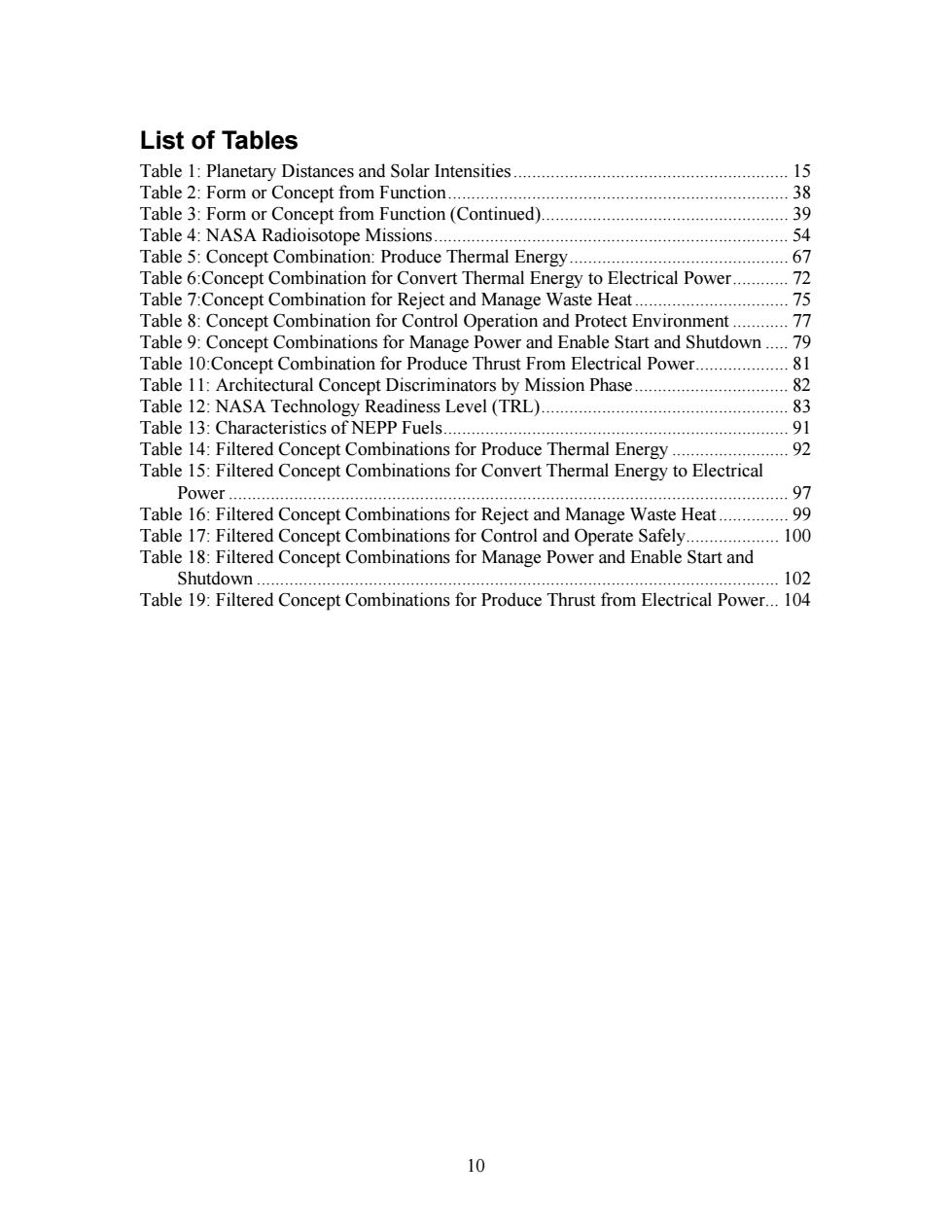
List of Tables Table 1:Planetary Distances and Solar Intensities........... .15 Table 2:Form or Concept from Function. 38 Table 3:Form or Concept from Function(Continued) 39 Table 4:NASA Radioisotope Missions........ 54 Table 5:Concept Combination:Produce Thermal Energy................................. 67 Table 6:Concept Combination for Convert Thermal Energy to Electrical Power........... 72 Table 7:Concept Combination for Reject and Manage Waste Heat....................... 75 Table 8:Concept Combination for Control Operation and Protect Environment 77 Table 9:Concept Combinations for Manage Power and Enable Start and Shutdown.....79 Table 10:Concept Combination for Produce Thrust From Electrical Power................... 81 Table 11:Architectural Concept Discriminators by Mission Phase..................... 82 Table 12:NASA Technology Readiness Level (TRL)............................................... 83 Table 13:Characteristics of NEPP Fuels........ 91 Table 14:Filtered Concept Combinations for Produce Thermal Energy..... 92 Table 15:Filtered Concept Combinations for Convert Thermal Energy to Electrical .97 Table 16:Filtered Concept Combinations for Reject and Manage Waste Heat............. 99 Table 17:Filtered Concept Combinations for Control and Operate Safely.................100 Table 18:Filtered Concept Combinations for Manage Power and Enable Start and Shutdown .102 Table 19:Filtered Concept Combinations for Produce Thrust from Electrical Power...104 10
List of Tables Table 1: Planetary Distances and Solar Intensities........................................................... 15 Table 2: Form or Concept from Function......................................................................... 38 Table 3: Form or Concept from Function (Continued)..................................................... 39 Table 4: NASA Radioisotope Missions............................................................................ 54 Table 5: Concept Combination: Produce Thermal Energy............................................... 67 Table 6:Concept Combination for Convert Thermal Energy to Electrical Power............ 72 Table 7:Concept Combination for Reject and Manage Waste Heat................................. 75 Table 8: Concept Combination for Control Operation and Protect Environment ............ 77 Table 9: Concept Combinations for Manage Power and Enable Start and Shutdown ..... 79 Table 10:Concept Combination for Produce Thrust From Electrical Power.................... 81 Table 11: Architectural Concept Discriminators by Mission Phase................................. 82 Table 12: NASA Technology Readiness Level (TRL)..................................................... 83 Table 13: Characteristics of NEPP Fuels.......................................................................... 91 Table 14: Filtered Concept Combinations for Produce Thermal Energy ......................... 92 Table 15: Filtered Concept Combinations for Convert Thermal Energy to Electrical Power ........................................................................................................................ 97 Table 16: Filtered Concept Combinations for Reject and Manage Waste Heat............... 99 Table 17: Filtered Concept Combinations for Control and Operate Safely.................... 100 Table 18: Filtered Concept Combinations for Manage Power and Enable Start and Shutdown ................................................................................................................ 102 Table 19: Filtered Concept Combinations for Produce Thrust from Electrical Power... 104 10
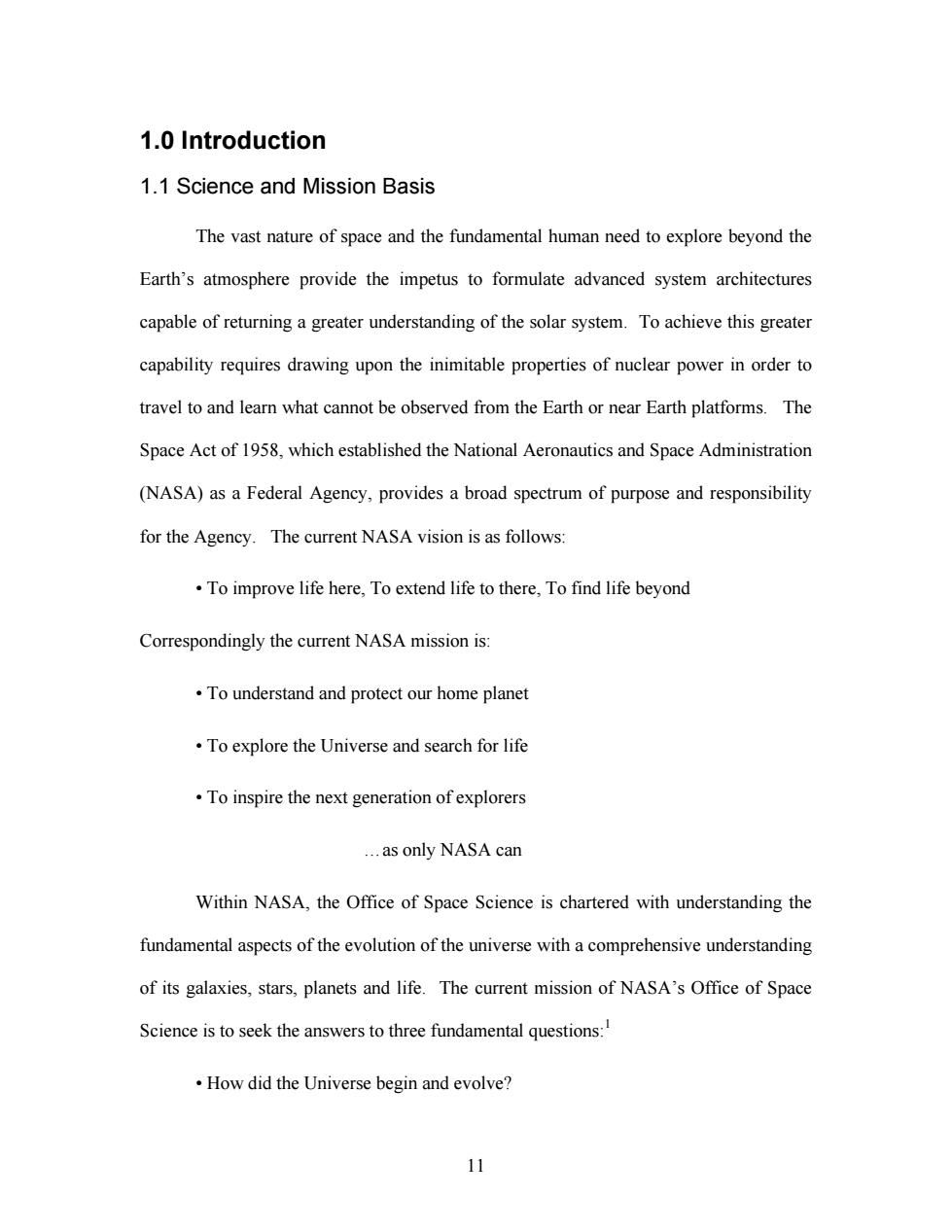
1.0 Introduction 1.1 Science and Mission Basis The vast nature of space and the fundamental human need to explore beyond the Earth's atmosphere provide the impetus to formulate advanced system architectures capable of returning a greater understanding of the solar system.To achieve this greater capability requires drawing upon the inimitable properties of nuclear power in order to travel to and learn what cannot be observed from the Earth or near Earth platforms.The Space Act of 1958,which established the National Aeronautics and Space Administration (NASA)as a Federal Agency,provides a broad spectrum of purpose and responsibility for the Agency.The current NASA vision is as follows: To improve life here,To extend life to there,To find life beyond Correspondingly the current NASA mission is: To understand and protect our home planet To explore the Universe and search for life To inspire the next generation of explorers ..as only NASA can Within NASA,the Office of Space Science is chartered with understanding the fundamental aspects of the evolution of the universe with a comprehensive understanding of its galaxies,stars,planets and life.The current mission of NASA's Office of Space Science is to seek the answers to three fundamental questions: How did the Universe begin and evolve? 11
1.0 Introduction 1.1 Science and Mission Basis The vast nature of space and the fundamental human need to explore beyond the Earth’s atmosphere provide the impetus to formulate advanced system architectures capable of returning a greater understanding of the solar system. To achieve this greater capability requires drawing upon the inimitable properties of nuclear power in order to travel to and learn what cannot be observed from the Earth or near Earth platforms. The Space Act of 1958, which established the National Aeronautics and Space Administration (NASA) as a Federal Agency, provides a broad spectrum of purpose and responsibility for the Agency. The current NASA vision is as follows: • To improve life here, To extend life to there, To find life beyond Correspondingly the current NASA mission is: • To understand and protect our home planet • To explore the Universe and search for life • To inspire the next generation of explorers …as only NASA can Within NASA, the Office of Space Science is chartered with understanding the fundamental aspects of the evolution of the universe with a comprehensive understanding of its galaxies, stars, planets and life. The current mission of NASA’s Office of Space Science is to seek the answers to three fundamental questions:1 • How did the Universe begin and evolve? 11